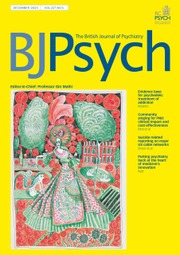We think in the form of either words or mental imagery. We know less about the latter. Mental imagery is like weak perception (without the percept), recruiting similar neural circuitry. Imagining daffodils, as Wordsworth wrote, ‘that flash upon that inward eye’ brings solace. Negative events flashing into mind, like intrusive memories of trauma, bring overwhelming emotions. Allowing time travel, imagery can ‘flashforward’ to suicide. By amplifying emotion and behaviour, imagery drives psychopathology across mental disorders. Directly asking patients about mental imagery benefits assessment. Being curious about mental imagery enriches the science of mental life and may also open doors clinically.
Article contents
100 words on mental imagery – 100 words
Published online by Cambridge University Press: 30 March 2020
Abstract
- Type
- Extras
- Information
- Copyright
- Copyright © The Authors 2020
- 6
- Cited by



eLetters
No eLetters have been published for this article.